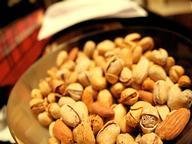Quiz Answer Key and Fun Facts
1. Are you nuts for nuts?
On a fruit and nut cake, four unlikely nuts have been sprinkled atop its spongy goodness. But, whilst the cake is not a lie, one of these nuts is, according to the resident botanist.
Tell me, which of them are not really nuts by botanical definition? If in doubt, pay heed to the way the nuts are encased in their shells.
2. Walking in the supermarket, I see a jar of Nutella. It's a spread, and despite the fact it looks like a chocolate spread from a passing glance, it's really a nut which is a more prominent ingredient, although not as high in quantity as the sugar and vegetable oils used!
Which nuts do they use in the creation of Nutella?
3. Are you a nutter? A nut gatherer, that is. Sometimes it's good to go to the source of where nuts really originate. This particularly hard shelled nut isn't native to Hawaii, despite the fact it is commercially grown there.
In fact, it's native to Australia. Can you identify the nut from this list?
4. Hurray, we're off to bake a wedding cake for the happy couple. We have most of the ingredients, but ... we're missing the nuts used to create the marzipan icing. In a nutshell, marzipan is made primarily of sugar and certain ground nuts, with variants including egg whites, corn syrup and rosewater.
To save the day from disaster, which nuts are used in the creation of marzipan?
5. Squirrels know the good nuts from the bad, although to be fair they are not particularly picky. However, we as humans are not squirrels, and wouldn't necessarily know off hand if we were out gathering.
Can you sort the good from the bad and tell me which of these nuts is NOT fit for human consumption in an unprocessed state, due to the caustic resin urushiol - the same as poison ivy's - within its shells?
6. I scream for ice cream. We all scream for ice cream. Except the lactose intolerant, perhaps, but there are alternatives for them, so we can all be happy. Which of these nuts often used as an addition to ice cream is harvested from a desert tree and was produced in the greatest quantity in Iran in 2005?
7. An intrepid explorer is searching through age old untouched ruins. Through booby traps he has endured, puzzles he has solved. Surely he is near some buried treasure? He proceeds to find... Several wrinkled nuts on an indented stand, arranged in a certain pattern. They spell the word DOOM. Without sensing the obvious descending from above, the explorer exclaims whilst cracking a nut open: "Ah, yes, this nut is native to Persia, of course! And, it hasn't even gone off... its antioxidants aren't that effective, so it can't have been here long!". Sadly, he is crushed by a stereotypical falling ceiling.
Which of these punny phrases best describes his situation and the nuts which spelt doom?
8. One of these nuts is guilty of murder! After eating one, a victim suffered an anaphylactic shock, which turned out to be fatal. An expert believes this nut is one of the leading causers of fatalities or near-fatalities in the nut world, and is also known as arachis hypogaea.
Can you arrest the right nut and close the case?
9. As a woman waves off her lover from a balcony, Romeo and Juliet style, she appears sorrowful at her lover leaving. To stave these feelings, she starts eating some chocolate and some aptly named nuts, which are also known in some cases for leaving a non-dangerous but irritating metallic lingering taste which lasts for up to 2 weeks after ingesting them. Which nuts are these?
10. A perhaps less well known nut is also known as the Philippine nut, and the Philippines is one of the only countries that produces this nut commercially. The kernel is a major ingredient in the Chinese delicacy moon cake, and its tree is tropical and can not withstand cold at all. Which nut is this?
Source: Author
malik24
This quiz was reviewed by FunTrivia editor
WesleyCrusher before going online.
Any errors found in FunTrivia content are routinely corrected through our feedback system.

